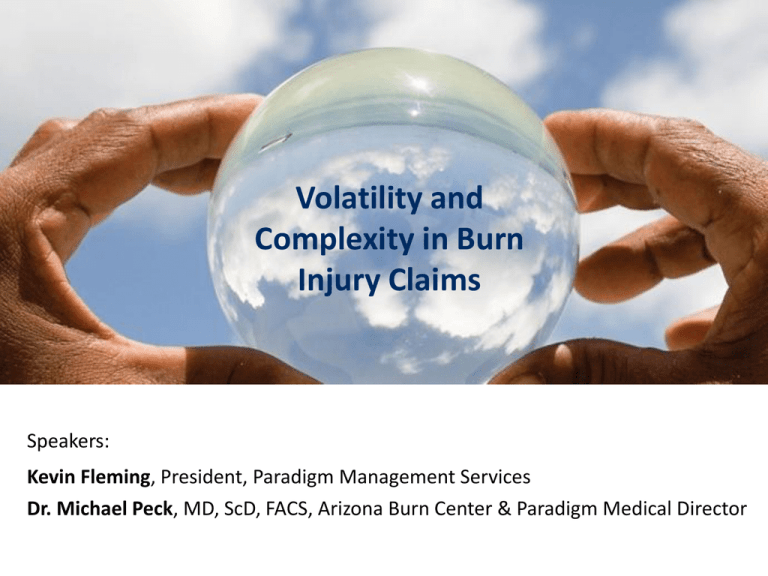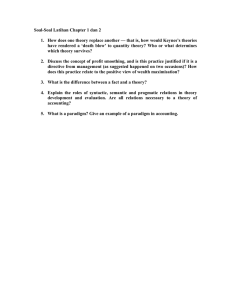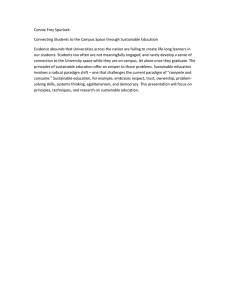
Volatility and
Complexity in Burn
Injury Claims
Speakers:
Kevin Fleming, President, Paradigm Management Services
Dr. Michael Peck, MD, ScD, FACS, Arizona Burn Center & Paradigm Medical Director
Welcome
Kevin Fleming, President, Paradigm
Thank you for joining us for our 2010 webinar series. Replays of past webinars are
available for viewing at www.paradigmcorp.com/webinars.
Volatility and Complexity in
Burn Injury Claims
Drug Management and Narcotics
Abuse in Workers Compensation
Multiple Issues with
Multiple Traumas
What Employers Should Know
About Complex Cases
© 2010 Paradigm Management Services, LLC All rights reserved
2
Housekeeping
Kevin Fleming, President, Paradigm
First a few housekeeping points….
■ Slides will advance automatically
■ Question & Answer period at end
■ You may submit questions at any time
– Click the “Q&A” button in the upper right
– Type a question into the lower section of
the Q&A panel that appears
– Ask All Panelists and be sure to click “Send”
– If we cannot answer during the session,
we will e-mail you
■ Replay will be available – look for our e-mail
■ When the webinar ends, a short survey will pop up
– There will be a CCMC section which must be
completed to receive continuing education credits
■ If you experience computer broadcast audio
problems, please use the dial in number posted in the
Chat panel on the right
© 2010 Paradigm Management Services, LLC All rights reserved
f
3
Incidence of Burn Injuries
Kevin Fleming, President, Paradigm
Each year there are approximately 600,000 burn injuries in the US. While most are
relatively mild, 60,000 require hospitalization and 5,000 a year result in death.
Distribution of Burn Incidence
by Percent of Total Body Surface Area (TBSA)
Today’s discussion focuses on
the most severe classes of burns
(as defined by degree, location,
and total body surface area)
Source: American Burn Association, National Burn Repository, 2009
© 2010 Paradigm Management Services, LLC All rights reserved
4
Today’s Webinar
Kevin Fleming, President, Paradigm
Severe burns are among the most complex injuries that a person can experience.
Electrical
4%
Chemical
3%
Other
4%
Contact with
hot object
9%
Fire/ Flame
40%
Non Contact
11%
Scald
30%
Burns Definition:
Damage to the skin or other
organic tissue caused by
thermal or acute trauma.
Source: American Burn Association, National Burn Repository, 2009
© 2010 Paradigm Management Services, LLC All rights reserved
5
Financial Implications
Kevin Fleming, President, Paradigm
A single injury can cost a payor millions of dollars, some as much as $10 million for
a single case if complications occur.
Burn Medical and Financial Volatility
$10m+
$10MM
The average medical
expenses are high,
but if complications
emerge, the costs can
be astronomical
$1,617,345
Average
Cost $$
$729,405
$457,058
$206,853
Complexity*
3 Low Intensity
4 High Intensity
5 Severe
6 Extremely Severe
Source: Paradigm mean values for medical costs years 2002-2008 adjusted for inflation (methodology likely understates risk exposure)
* Complexity is a Paradigm Management Services proprietary scale assigned after a multivariate analysis containing more than 800 variables. Level 1: Minimal
treatment, 2: Routine treatment, 3: Low-intensity treatment, 4: High-intensity treatment, 5: Severe, 6: Extremely severe.
© 2010 Paradigm Management Services, LLC All rights reserved
6
Guest Speaker: Dr. Michael Peck, MD, ScD, FACS
Kevin Fleming, President, Paradigm
With us today is Dr. Michael Peck, MD, ScD, FACS from the Arizona Burn Center and
a long-time Paradigm Medical Director.
Dr. Peck is currently the Director of Ambulatory and
Outreach Programs for the Arizona Burn Center.
Prior to this position, Dr. Peck spent 11 years as Medical
Director of the North Carolina Jaycee Burn Center and was
a Professor of Surgery at the University of North Carolina
at Chapel Hill.
© 2010 Paradigm Management Services, LLC All rights reserved
7
Burn Categorization
Dr. Michael Peck, MD, ScD, FACS
Burn are classified according to the depth of tissue injury. Severe burns often have
a mixture of damage levels.
Degree of Burn
1st 2nd 3rd 4th
Epidermis
Dermis
Subcutaneous
Tissue
Muscle
© 2010 Paradigm Management Services, LLC All rights reserved
8
Burn Categorization
Dr. Michael Peck, MD, ScD, FACS
These pictures show the appearance of the different levels of burn damage.
Second Degree –
Partial Thickness
First Degree –
Superficial
Third Degree –
Full Thickness
Fourth Degree –
Full Thickness
© 2010 Paradigm Management Services, LLC All rights reserved
9
How Burns Heal
Dr. Michael Peck, MD, ScD, FACS
Burn care requires a series of ongoing, but separate, interventions until healing of
all wounds is achieved.
Burn Healing
■ Wounds heal by scar contracture
■ Must fight this from day one
Key surgical treatments:
Incisions through
eschar to release
constricting tissue
Escharotomy
Removal of
loose, devitalized, n
ecrotic and
contaminated tissue
Debridement
Incisions through
deep dermis to
open tissue and
prepare for covering
Excision
Surgical close of
wounds with
harvested or
synthetic skin
Grafting
■ Appropriate care may require multiple treatment modalities, each with varying sequencing
© 2010 Paradigm Management Services, LLC All rights reserved
10
Surviving Burn Injuries
Dr. Michael Peck, MD, ScD, FACS
With most burns the risk of death occurs well after the initial injury.
Mortality Rate
■
% Total Body Surface Area
90+
80%
80 to 90
69%
70 to 80
43%
50 to 60
24%
30 to 40
0 to 10
Severe respiratory failure
from smoke inhalation injury
–
Very large (>80% body
surface) burns
36%
40 to 50
10 to 20
–
57%
60 to 70
20 to 30
Few patients die within the first 48
hours
■
16%
Most deaths occur after 2-3 weeks
as a result of septic shock
–
8%
3%
Immune system
compromised by burns
1%
Source: American Burn Association, National Burn Repository, 2009
© 2010 Paradigm Management Services, LLC All rights reserved
11
Immediate Intervention
Dr. Michael Peck, MD, ScD, FACS
The most immediate things to tend to include breathing, early excision and infection
prevention.
Prompt attention to intubation, ventilator support, and fluid resuscitation
Early excision and grafting of the burns
Appropriate nutritional support
Attention to prevention,
recognition, and treatment of
infections
© 2010 Paradigm Management Services, LLC All rights reserved
12
Smoke Inhalation
Dr. Michael Peck, MD, ScD, FACS
With smoke inhalation injuries, there are a number of key factors to consider.
Carbon monoxide poisoning
Injury above or below the glottis
Supra-Glottic inhalation injury
—
Thermal injury
—
Edema threatens airway patency
—
Injury below the vocal cords is not thermal
—
Injury below the cords is from toxicants in smoke
Diagnosis
—
History of being burned in a close space
—
Facial burns
—
Respiratory distress
—
Bronchoscopy not necessary in ER; used in ICU
for prognostic, diagnostic, and (sometimes)
therapeutic reasons
© 2010 Paradigm Management Services, LLC All rights reserved
13
Electrical Burn
Dr. Michael Peck, MD, ScD, FACS
The same is true of electrical injuries – additional factors must be considered.
Body tissues have high resistance to current flow
— Least resistance from nerves and muscles
— Most resistance from tendons, ligaments, and
especially bone, where electrical energy is converted
to heat; wrist and ankle often deeply injured
Electrical injuries impact multiple systems and damage
can evolve over time
— Heart: Cardiac arrest, anoxic brain damage, and
cardiac arrhythmias
— Kidney: Kidney failure caused by myoglobin from
damaged muscle tissue
— Nerves: Brain, spinal cord, peripheral nerves, altered
thinking processes, sometimes many months later
— Eyes: Cataracts months or years after injury
— Programmed cell death
— Narrowing and obstruction of blood vessels
© 2010 Paradigm Management Services, LLC All rights reserved
14
Case Study
Dr. Michael Peck, MD, ScD, FACS
It is not uncommon for a patient to need multiple operations and re-grafting
procedures.
Situation: 25 year old man (1.8 m2 body surface area), otherwise healthy, sustains third degree
burns over 75% (13,500 cm2) of his body after falling into a vat of sodium hydroxide.
Day
1
Life flight
to ER
2
3
4
5
6
8
9
10
…
16
…
Develops
Pneumonia
Second OR visit for
Excision and Allograft
on Chest & Abdomen
(≈15% TBSA)
• Necrosis on hands results
in re-excision and allografting
First OR visit for
Excision & Allograft
on Hands & Arms
(≈15% TBSA)
7
Third OR visit for
Excision and Allograft
on Back and Buttocks
(≈15% TBSA)
Fourth OR visit for
Excision and Allograft
on Legs and Feet
(≈30% TBSA)
Sixth OR visit for
Inspection and
replacement of all
allografts
• Repeat excision and allografting
on back and chest
• Rejected arm and abdomen
allograph replaced
• Repeat excision and allografting
on areas of chest and abdomen
• New allograft applied to arms, and
split thickness allograft to hands using
skin harvested from upper arms
Fifth OR visit for
Inspection
20
…
26
…29
…40
Eighth OR Visit for
repeat abdomen and
thigh allografting
Seventh OR Visit
for repeat lower
back allografting
Ninth OR Visit for
repeat leg and foot
allografting
Tenth and Final OR
visit of Acute Phase
of Care for
additional leg and
foot allografting
• Repeat excision and allografting
on back using skin from buttocks
© 2010 Paradigm Management Services, LLC All rights reserved
15
Poll #1: Hospital Stay
What is the average length of hospital stay for a
patient with a 75% TBSA burn injury?
A. 31 days
Use the Polling
Panel on the
right to enter
your answer
now.
Be sure to click
“Submit.”
B. 54 days
C. 76 days
D. 93 days
Source: American Burn Association, National Burn Repository, 2009
© 2010 Paradigm Management Services, LLC All rights reserved
16
Poll #2: Hospital Cost
What is the average cost of hospital stay for a
patient with a 75% TBSA burn injury?
A. $302,000
Use the Polling
Panel on the
right to enter
your answer
now.
Be sure to click
“Submit.”
B. $443,000
C. $597,000
D. $741,000
Source: American Burn Association, National Burn Repository, 2009
© 2010 Paradigm Management Services, LLC All rights reserved
17
Most Common Complications
Dr. Michael Peck, MD, ScD, FACS
Complications are common, so patients need 18-36 months of meticulous evaluation
and correction of fluid/ electrolyte, metabolic, cardiopulmonary, homeostatic and
infectious derangements.
Frequency and Cost of Top 10 Clinically Relevant Complications
Additional expense
due to complication
($000)
$28–135
66%
% Incidence of
complications among
severely injured burn
victims
$16-75
57%
$38-107
55%
$58-120
35%
$37-110
32%
$14-80
29%
$44-132
27%
$58-112
19%
$32-117
17%
$58-226
14%
$18-68
13%
Source: Paradigm case experience/data extract
© 2010 Paradigm Management Services, LLC All rights reserved
18
Getting the Best Outcomes
Dr. Michael Peck, MD, ScD, FACS
A process involving Systematic Care Management SM can greatly improve the
outcome/success of the patient's recovery.
Client Environment
■ Medical experts: oversight/coordination by skilled
burn physician and onsite nurse case manager
Paradigm Medical Hub
■ Top providers: burn center with multidisciplinary
approach to burn care:
– MDs
– Burn RNs
– Physical Therapist
– Occupational Therapist
– Nutritionist
– Psychologist
Medical Experts
NWM
Onsite
Nurses
Top Providers
Paradigm
Clinical Team
Trauma
Centers
PMD
Physicians
Data on
10,000+
Cases
Acute
Rehab
Post-Acute/
Outpatient
Custom Built Infrastructure
Analytics/
Algorithms
EBM+
Standards
Provider
Tracking
Outcome
Guarantees
■ Infrastructure: relevant data, standards, and
outcome planning and guarantees
© 2010 Paradigm Management Services, LLC All rights reserved
19
Physical Management Issues
Dr. Michael Peck, MD, ScD, FACS
In the weeks that follow a burn there are a number of
key issues that need to be monitored closely.
Key Issues:
Respiratory Dysfunction
Malnutrition
Neuropathies
Hypertrophic Scarring
Amputations
Decreased Strength and Endurance
Altered Sensation and Function Of Skin
© 2010 Paradigm Management Services, LLC All rights reserved
20
Psychological Management Issues
Dr. Michael Peck, MD, ScD, FACS
With severe burn injuries, there are also a number of psychological issues that need
to be managed and mitigated.
Key Issues:
Substance abuse
Anxiety disorders
Chronic pain syndromes
Altered self-image
Depression
Post-traumatic stress syndrome
© 2010 Paradigm Management Services, LLC All rights reserved
21
Results
Kevin Fleming, President, Paradigm
Using Systematic Care Management SM we are able to achieve outcomes far above
those within the general industry.
Burn Injury Outcomes
Release to
Return to Work
Returned to
Work Full Duty
64%
2x
Better
55%
3.5x
Better
30%
15%
Industry
Benchmark1
Paradigm
Industry
Benchmark1
Paradigm
1. Based on an independent comparison by Milliman, the nation’s leading actuarial and consulting firm, to their proprietary database of similar
WC claims; Return to Work timing based on attending physician’s judgment (not Paradigm’s)
© 2010 Paradigm Management Services, LLC All rights reserved
22
Summary
Kevin Fleming, President, Paradigm
We hope you will join us for future webinars and leave knowing the following.
Burn are among the most complex
and costly types of injuries
Burn care is highly involved and
fraught with complications
Constant monitoring and sequential
interventions are necessary for recovery
Paradigm has successfully proven the value of
the models during the past 20 years
© 2010 Paradigm Management Services, LLC All rights reserved
23
Question and Answer Session
Please submit your questions for our panelists in the Q&A window on the right.
Today’s speakers:
Kevin Fleming
Dr. Michael Peck, MD, ScD, FACS
President
Paradigm Management Services
Director of Ambulatory and Outreach
Programs , Arizona Burn Center
and Paradigm Medical Director
Reminder: If you experience computer broadcast audio problems, please use
the following dial-in number:
Toll Free 866-699-3239
Passcode 663 351 016 # #
© 2010 Paradigm Management Services, LLC All rights reserved
24




